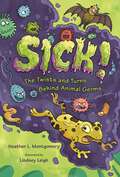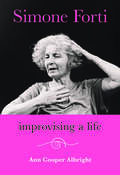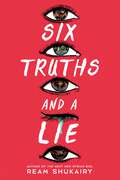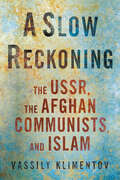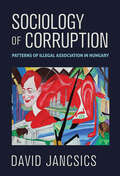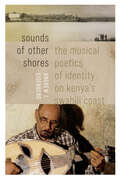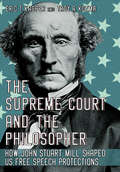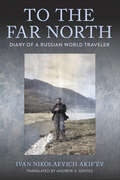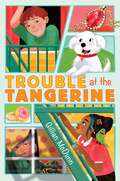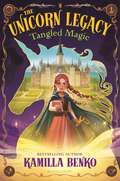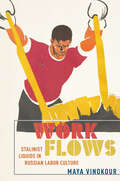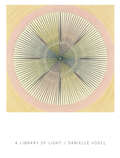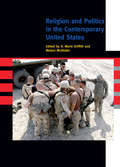- Table View
- List View
Sick!: The Twists and Turns Behind Animal Germs
by Heather L. MontgomeryWhen a super sickness lands on the land, when a parasite becomes more than a pest, when an infection ignites an epidemic, what's a body to do? Your body is an animal body, so why not ask the animals?Follow the scientists, around the world and into their labs, who are studying animals and the germs that attack them. From fungus-ridden frogs with fevers to bacteria-resistant buzzards and everything in-between, animals have A LOT to teach us about infections. But-reader beware!!-the story of germs is filled with twists and turns.In this fascinating, highly visual nonfiction book packed with colorful, comic-style art, you'll discover not only the cool ways that animal bodies (and our bodies) fight back against pesky pathogens, but also the amazing and surprising ways we can learn to work together with germs.Sick! The Twists and Turns Behind Animal Germs is written by Heather L. Montgomery with graphic novel-style art from Lindsey Leigh.
Simone Forti: Improvising a Life
by Ann Cooper AlbrightSimone Forti, groundbreaking improvisor, has spent a lifetime weaving together the movement of her mind with the movement of her body to create a unique oeuvre situated at the intersection of dancing and art practices. Her seminal Dance Constructions from the 1960s crafted a new approach to dance composition and helped inspire the investigations of Judson Dance Theater. In the 1970s, Forti's explorations of animal movements expanded that legacy to launch improvisation as a valuable artform in its own right. From her early forays into vocal accompaniment to her News Animations, Forti has long integrated gesture and text into compelling performances that consistently stretched the boundaries of dance to layer abstract movement with story-telling and political commentary. Her "Land Portraits" series brought an immersive ecological experience to New York City stages in the 1980s, and she is a beloved teacher and mentor whose Body, Mind, World workshops have inspired dancers around the world. In this beautifully written book, author Ann Cooper Albright braids archival research, extensive interviews, and detailed movement analyses of Forti's performances to provide the first kinesthetically-informed and critically-nuanced history of Forti's multifaceted and extensive career.Publication of this book is funded by the Beatrice Fox Auerbach Foundation Fund at the Hartford Foundation for Public Giving.
Six Truths and a Lie
by Ream ShukairySix Muslim teens are falsely accused of a deadly attack in this timely and harrowing examination of America&’s justice system, perfect for fans of Angie Thomas and Samira Ahmed. As fireworks pop off at a rowdy Fourth of July bonfire party, an explosion off the California coast levels an oil rig—resulting in chaos and worse, murder. At the center are six Muslim teens - six patriots, six strangers, and six suspects. An old soul caught in the wrong place. An aspiring doctor. An influencer with a reputation to protect. A perfect daughter with secrets to hide. A soccer star headed for Stanford. An immigrant in love. Each with something to hide and everything to lose. Faced with accusations of terrorism, The Six are caught in a political game that will pit them against each other in exchange for exoneration. They must choose: frame each other to guarantee their own independence or expose their secrets to earn back freedom for them all.
A Slow Reckoning: The USSR, the Afghan Communists, and Islam (NIU Series in Slavic, East European, and Eurasian Studies)
by Vassily KlimentovA Slow Reckoning examines the Soviet Union's and the Afghan communists' views of and policies toward Islam and Islamism during the Soviet-Afghan War (1979–1989). As Vassily Klimentov demonstrates, the Soviet and communist Afghan disregard for Islam was telling of the overall communist approach to reforming Afghanistan and helps explain the failure of their modernization project.A Slow Reckoning reveals how during most of the conflict Babrak Karmal, the ruler installed by the Soviets, instrumentalized Islam in support of his rule while retaining a Marxist-Leninist platform. Similarly, the Soviets at all levels failed to give Islam its due importance as communist ideology and military considerations dominated their decision making. This approach to Islam only changed after Mikhail Gorbachev replaced Karmal by Mohammad Najibullah and prepared to withdraw Soviet forces. Discarding Marxism-Leninism for Islam proved the correct approach, but it came too late to salvage the Soviet nation-building project. A Slow Reckoning also shows how Soviet leaders only started seriously paying attention to an Islamist threat from Afghanistan to Central Asia after 1986. While the Soviets had concerns related to Islamism in 1979, only the KGB believed the threat to be potent. The Soviet elites never fully conceptualized Islamism, continuing to see it as an ideology the United States, Iran, or Pakistan could instrumentalize at will. They believed the Islamists had little agency and that their retrograde ideology could not find massive appeal among progressive Soviet Muslims. In this, they were only partly right.
Sociology of Corruption: Patterns of Illegal Association in Hungary
by David JancsicsIn Sociology of Corruption, David Jancsics provides a fresh approach to the study of corruption in Hungary, which once seemed to be the most likely of the ex-communist bloc nations to catch up to the West and is, according to many experts and scholars, a country with a highly corrupt dynamic.Based on data from 2022, Hungary is now the most corrupt member state of the European Union. There is also a consensus among experts that a small clique of corrupt political actors has captured most Hungarian state institutions and a significant portion of the business sector. What fostered corruption in Hungary? What are the most typical forms of corruption in this country? What do Hungarians think about it? What is the role of prime minister Viktor Orbán in this? Sociology of Corruption proposes a novel sociological theory of corruption focusing on social status and relationships, network structures, and power dynamics as important explanatory factors of corrupt behavior. Although his focus is on Hungary, Jancsics's findings are applicable to other nations and cultural contexts.
Sounds of Other Shores: The Musical Poetics of Identity on Kenya's Swahili Coast (Music / Culture)
by Andrew J. EisenbergSounds of Other Shores takes an ethnographic ear to the history of transoceanic stylistic appropriation in the Swahili taarab music of the Kenyan coast. Swahili taarab, a form of sung poetry that emerged as East Africa's first mass-mediated popular music in the 1930s, is a famously cosmopolitan form, rich in audible influences from across the Indian Ocean. But the variants of the genre that emerged in the Kenyan coastal city of Mombasa during the twentieth century feature particularly dramatic, even flamboyant, appropriations of Indian and Arab sonic gestures and styles. Combining oral history, interpretive ethnography, and musical analysis, Sounds of Other Shores explores how Swahili-speaking Muslims in twentieth-century Mombasa derived pleasure and meaning from acts of transoceanic musical appropriation, arguing that these acts served as ways of reflecting on and mediating the complexities and contradictions associated with being "Swahili" in colonial and postcolonial Kenya. The result is a musical anthropology of Kenyan Swahili subjectivity that reframes longstanding questions about Swahili identity while contributing to broader discussions about identity and citizenship in Africa and the Indian Ocean world.
The Supreme Court and the Philosopher: How John Stuart Mill Shaped US Free Speech Protections
by Eric T. Kasper Troy A. KozmaThe Supreme Court and the Philosopher illustrates how the modern US Supreme Court has increasingly adopted a view of the constitutional right to the freedom of expression that is classically liberal in nature, reflecting John Stuart Mill's reasoning in On Liberty. A landmark treatise outlining the merits of limiting governmental and social power over the individual, On Liberty advocates for a maximum protection of human freedom. Proceeding case by case and covering a wide array of issues, such as campaign finance, offensive speech, symbolic speech, commercial speech, online expression, and false statements, Eric T. Kasper and Troy A. Kozma show how the Supreme Court justices have struck down numerous laws for infringing on the freedom of expression.Kasper and Kozma demonstrate how the adoption of Mill's version of free speech began with Justice Oliver Wendell Holmes Jr. more than a century ago and expanded over time to become the prevailing position of the Court today. The authors argue that this embrace of Mill's rationale has led to an unmistakable reorientation in the Court's understanding of free expression jurisprudence.The Supreme Court and the Philosopher is the first book to comprehensively explore how the political philosophy of Mill has influenced the highest court in the land. In targeting the underlying philosophical reasons that explain why the modern Supreme Court renders its First Amendment decisions, this book is particularly timely, as the issues of censorship and freedom of expression are debated in the public square today.
To the Far North: Diary of a Russian World Traveler (NIU Series in Slavic, East European, and Eurasian Studies)
by Ivan Nikolaevich Akif’ëvThis annotated translation of To the Far North presents the diary of a twenty-seven-year-old Russian physician who was part of the 1900 expedition to the Chukotka Peninsula to find gold. No other account so richly details life along the North Pacific Rim before World War I, especially from a Russian perspective. This volume relates the expedition's formation, development, and aftermath and offers unique insights on the region's place in both Russian policymaking and geopolitics. The illustrated diary includes picturesque descriptions of San Francisco, the Nome Gold Rush, Chukchi culture, Petropavlovsk, Vladivostok, and Nagasaki, Japan.Andrew A. Gentes's translation is based on an edition of Akifëv's book that was published in St. Petersburg in 1904. The diary shows how Russian and American views and cultural values clashed over a territory that is today more geopolitically important than ever. By documenting Akifëv's personal travels outside the expedition, To the Far North also demonstrates, in both human and personal terms, the role Russians played in shaping this region's history.
Trouble at the Tangerine
by Gillian McDunnAward-winning author Gillian McDunn pens a delightfully quirky mystery that examines the meaning of home, perfect for fans of The Vanderbeekers series.Simon's family is always on the move. Every few months, they load up their van, “Vincent Van Go,” and set off for a new adventure. According to his dad, you can't live an extraordinary life by staying in one place. But all Simon wants is to settle down, so he's hatched a plan: to make their latest apartment in the Tangerine Pines building his forever home.When a priceless necklace is stolen, clues indicate the thief might actually be another neighbor. Simon worries he'll have to move again if the thief isn't caught. He usually doesn't go looking for trouble, but if retrieving the necklace means establishing home, Simon is willing to risk it. With the help of his neighbor Amaya, pet sitter, plant-waterer, and podcaster extraordinaire, Simon is determined to crack the case and finally put down roots.
The Unicorn Legacy: Tangled Magic
by Kamilla Benko"A sparkling page-turner full of surprising twists, clever girls, and magical wonders!" -Tui Sutherland, #1 New York Times bestselling author of the Wings of Fire seriesFrom the creator of The Unicorn Quest series, a wondrous new series set in the magical land of Arden, full of unicorns and mystery!Magic pulses bright in Arden, a world where humans who craft magic have been at war and separated for hundreds of years. Now a new era has dawned, the unicorns have returned, and the prime minister has decreed that apprentices from all four guilds will learn in the newly formed Unicorn Academy. But peace is tenuous: As rumors spread of dark magic and of unicorns disappearing, twelve-year-old apprentice Olivia Hayes is caught between her joy at newfound magical abilities at the academy and proving to everyone that her older sister, Laurel, is NOT a unicorn poacher. She and her friends must untangle the truth and the secrets of the past to spin a stronger future-or else the unicorns of Arden may be lost forever. This sweeping middle grade fantasy is about friendship, choice, and the ties that truly matter.
Work Flows: Stalinist Liquids in Russian Labor Culture (NIU Series in Slavic, East European, and Eurasian Studies)
by Maya VinokourWork Flows investigates the emergence of "flow" as a crucial metaphor within Russian labor culture since 1870. Maya Vinokour frames concern with fluid channeling as immanent to vertical power structures—whether that verticality derives from the state, as in Stalin's Soviet Union and present-day Russia, or from the proliferation of corporate monopolies, as in the contemporary Anglo-American West. Originating in pre-revolutionary bio-utopianism, the Russian rhetoric of liquids and flow reached an apotheosis during Stalin's First Five-Year Plan and re-emerged in post-Soviet "managed democracy" and Western neoliberalism.The literary, philosophical, and official texts that Work Flows examines give voice to the Stalinist ambition of reforging not merely individual bodies, but space and time themselves. By mobilizing the understudied thematic of fluidity, Vinokour offers insight into the nexus of philosophy, literature, and science that underpinned Stalinism and remains influential today. Work Flows demonstrates that Stalinism is not a historical phenomenon restricted to the period 1922-1953, but a symptom of modernity as it emerged in the twentieth century. Stalinism's legacy extends far beyond the bounds of the former Soviet Union, emerging in seemingly disparate settings like post-Soviet Russia and Silicon Valley.
A Library of Light (Wesleyan Poetry Series)
by Danielle VogelWhen poet Danielle Vogel began writing meditations on the syntax of earthen and astral light, she had no idea that her mother's tragic death would eclipse the writing of that book, turning her attention to grief's syntax and quiet fields of cellular light in the form of memory. Written in elegant, crystalline prose poems, A Library of Light is a memoir that begins and ends in an incantatory space, one in which light speaks. At the book's center glows a more localized light: the voice of the poet as she reflects, with ceremonial patience, on the bioluminescence of the human body, language's relationship to lineage, her mother's journals written during years of estrangement from her daughter, and the healing potential of poetry. A mesmerizing elegy infused with studies of epigenetic theory and biophotonics, A Library of Light shows that to language is to take part in transmission, transmutation of energy, and sonic (re)patterning of biological light.[sample poem]When we are. When we are there, we lay together and cover ourselves with our voices. When we are ten, we are also twenty-one. We speak of breathing, but this is a thing we cannot do. When we are seven, we are also eighteen. When we are eighteen, we begin our bodies. But we are unmappable,unhinged. A resynchronization of codes, thecrystalline frequencies of stars, seeds, vowels, lying dormant within you. We are the oldest dialect. Asound the voice cannot make but makes.
Religion and Politics in the Contemporary United States (A Special Issue of<I> American Quarterly</I> <I> </I>)
by R. Marie Griffith Melani McAlisterThis collection of essays from a special issue of American Quarterly explores the complex and sometimes contradictory ways that religion matters in contemporary public life.Religion and Politics in the Contemporary United States offers a groundbreaking, cross-disciplinary conversation between scholars in American studies and religious studies. The contributors explore numerous modes through which religious faith has mobilized political action. They utilize a variety of definitions of politics, ranging from lobbying by religious leaders to the political impact of popular culture. Their work includes the political activities of a very diverse group of religious believers: Christians, Jews, Muslims, Hindus, Buddhists, and others. In addition, the book explores the meanings of religion for people who might contest the term—those who are spiritual but not religious, for example, as well as activists who engage symbols of faith and community but who may not necessarily consider themselves members of a specific religion. Several essays also examine the meanings of secular identity, humanist politics, and the complex evocations of civil religion in American life.No other book on religion and politics includes anything like the diversity of religions, ethnicities, and topics that this one does—from Mormon political mobilization to attempts at Americanizing Muslims in the post-9/11 United States, from César Chávez to James Dobson, from interreligious cooperation and conflict over Darfur to the global politics surrounding the category of Hindus and South Asians in the United States.
